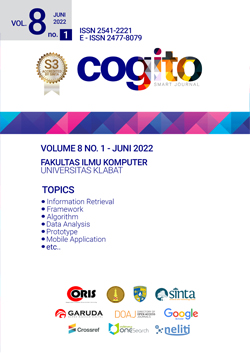Web Based Video Conference Application for Online Learning Media
DOI:
https://doi.org/10.31154/cogito.v8i1.337.25-34Abstract
The COVID-19 pandemic has created the need for online learning activities at schools and universities. The use of the video conference application itself is one of the most important alternatives to traditional learning activities. According to researchers, the main issues are the high cost of existing applications and the limitation of access devices. There are three main phases in developing this application: server preparation, application development, and implementation. This application was developed using WebRTC, Jitsi JICOFO, Prosody XMPP server, and Nginx web server. The technical maturity of this study is two, the construction of this application is practical, and the examples are limited to the study and speculative. The purpose of this study is to create a web-based video conferencing application that can be accessed from anywhere without logging in with a web browser alone, has a limited time, and can be attended by over 100 users.References
G. Agosti, "Distance Education in the Era of Internet," in Encyclopedia of Developing Regional Communities with Information and Communication Technology, 2006.
A. Sadikin and A. Hamidah, "Pembelajaran Daring di Tengah Wabah Covid-19," BIODIK Jurnal Ilmiah Pendidikan Biologi, vol. IV, no. 2, pp. 214-224, 2020.
A. H. Rustaman, "Efektifitas Penggunaan Aplikasi Daring, Video Confrence dan Sosial Media pada Mata Kuliah," JISIP: Jurnal Ilmu Sosial dan Pendidikan, pp. 557-562, 2020.
Zoom Video Communications, Inc, "Zoom Us: Pricing," 21 October 2020. [Online]. Available: https://zoom.us/pricing.
IDCloudhost.com, "Video Confrence: Pengertian, Fungsi, Manfaat, dan Rekomendasi Aplikasi," idcloudhost.com, 6 may 2020. [Online]. Available: https://idcloudhost.com/videoconference-pengertian-fungsi-manfaat-dan-rekomendasiaplikasi.
dewaweb.com, "Video Confrence: Tetap Asyik Bekerja Tanpa Tatap Muka.," 25 March 2020. [Online]. Available: https://www.dewaweb.com/blog/video-conference/.
quipper.com, "Apa itu E-Learning?," 2020 April 20. [Online]. Available: https://www.quipper.com/id/blog/tips-trick/school-life/apa-itu-elearning/.
jitsi.org, "Jitsi Videobridge," 2018. [Online]. Available: https://jitsi.org/jitsivideobridge.
prosody.im, "What is Prosody," 01 October 2020. [Online]. Available: https://prosody.im/.
nginx.org, "nginx," 01 January 2020. [Online]. Available: http://nginx.org/en/.
Yasin, "Apa itu Nginx dan Cara Kerjanya," 21 July 2019. [Online]. Available: https://www.niagahoster.co.id/blog/nginx-adalah/.
Downloads
Published
How to Cite
Issue
Section
License
Copyright (c) 2022 CogITo Smart Journal

This work is licensed under a Creative Commons Attribution 4.0 International License.
Authors who publish with this journal agree to the following terms:- Authors retain copyright and grant the journal right of first publication with the work simultaneously licensed under a Creative Commons Attribution License that allows others to share the work with an acknowledgment of the work's authorship and initial publication in this journal.
- Authors are able to enter into separate, additional contractual arrangements for the non-exclusive distribution of the journal's published version of the work (e.g., post it to an institutional repository or publish it in a book), with an acknowledgment of its initial publication in this journal.
- Authors are permitted and encouraged to post their work online (e.g., in institutional repositories or on their website) prior to and during the submission process, as it can lead to productive exchanges, as well as earlier and greater citation of published work (See The Effect of Open Access).





























